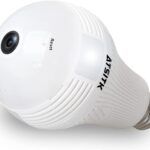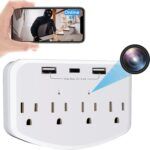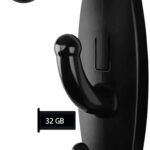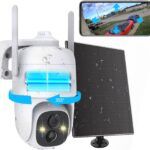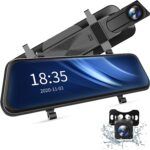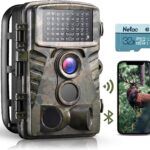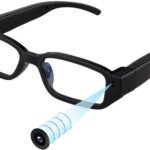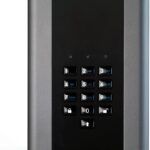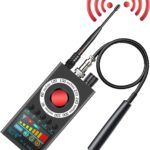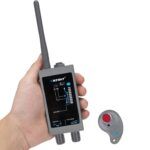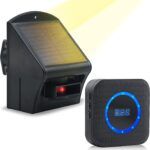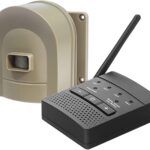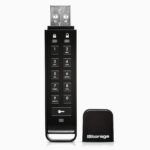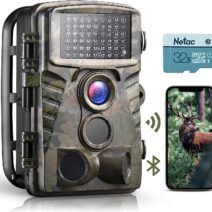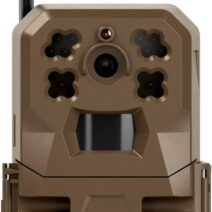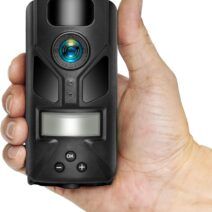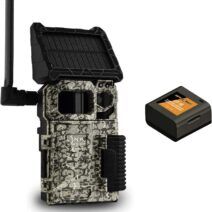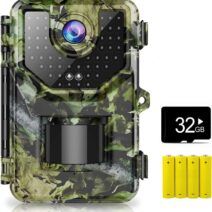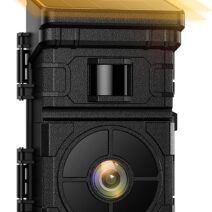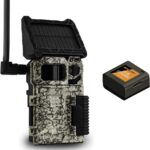- What are trail cameras used for?
Trail or game cameras are primarily used by hunters and wildlife enthusiasts to capture images or videos of wildlife in their natural habitat. These cameras are designed to be durable and weatherproof, making them ideal for outdoor use. They are often used to track the movements and behavior of game animals, such as deer, elk, and wild boar, for hunting and wildlife management purposes.
Apart from hunting and wildlife observation, trail cams can also be used as home surveillance cameras, as well as surveillance of wood cabins, mountain lodges, and farm crops. They are often used to monitor the activities of trespassers, burglars, and other intruders. Trail cameras can be set up to detect motion and capture images or videos automatically, making them a convenient and effective way to keep an eye on remote or hard-to-reach locations.
- How long do trail cam batteries last?
The battery life of a trail camera varies depending on the quality of the battery, the type of camera, and the frequency of use. In general, most trail cameras can last for several weeks to a few months on a single set of disposable batteries, but it’s always a good idea to have extra batteries on hand in case they run out. Many trail cameras come with low-battery indicators, so you’ll know when it’s time to replace them. It’s also important to remember that extreme temperatures can affect battery life, so it’s important to use high-quality batteries and store the camera in a temperate environment.
Some trail cameras also offer the option of using rechargeable batteries, which can save money in the long run and reduce waste. However, it’s important to make sure that the rechargeable batteries are compatible with the camera and have a high enough capacity to last for the desired amount of time. Furthermore, some cams have an internal battery that can be recharged with solar panels, allowing for many months of usage.
- How do I view trail camera footage?
There are several ways to view trail cam footage, depending on the type of camera you have. Most trail cameras store footage on an SD card, which can be removed from the camera and inserted into a computer or other device with an SD card reader. Some trail cameras also have wireless capabilities and allow you to view footage remotely through a mobile app or online platform. However, wireless trail cameras require a cellular plan or Wi-Fi network to connect to external devices.
Additionally, many newer trail cams also feature a built-in viewing screen, allowing you to preview and review footage directly on the camera itself. This can be a convenient option for those who want to quickly check their footage while out in the field without having to bring a separate device.
- Do trail cameras have audio recording?
Trail cameras typically do not come with audio recording capabilities. This is because the primary purpose of these cameras is to capture images and videos of wildlife for research, hunting or photography purposes. Audio recording is usually not necessary for these activities. However, some newer models of trail cameras may come equipped with audio recording features, but this is not a standard feature. If audio recording is important for your specific use case, you should check the product specifications before purchasing a trail camera. Additionally, it’s important to be aware of any laws or regulations in your area that may restrict the use of audio recording on wildlife or private property.
- Can I use a trail cam for security purposes?
Trail cams can be used for security purposes as they are motion-activated and can capture photos and videos of trespassers or burglars on your property. They can also be set up to monitor entrances, exits, and areas of high traffic, providing an added level of security to your home or business. However, trail cameras may not offer the same features and capabilities as traditional security cameras, such as remote viewing and notifications.
When using trail cameras for security purposes, it’s essential to ensure that they are placed in locations where they are not easily visible or accessible to intruders. They should also be securely mounted and locked to prevent theft or tampering.
- Can trail cameras be used in extreme temperatures?
Most trail cameras are built to withstand extreme temperatures and weather conditions, making them perfect for outdoor use. These cameras are often designed with durable, weather-resistant casings that can protect them from rain, snow, and extreme temperatures.
However, the operating temperature range of a trail camera can vary depending on the manufacturer and model. To ensure that your trail camera is suitable for use in extreme temperatures, it’s best to check the manufacturer’s specifications and recommended operating temperature range.
Some trail cameras are designed to work in temperatures as low as -20°F, while others may only be suitable for use in temperatures above freezing. Extremely high temperatures can cause damage to the camera’s internal components and shorten its lifespan, so it’s important to use caution and monitor the camera’s performance during periods of extreme heat.
- Can trail cameras be used at night?
Nearly all trail cameras are designed to be used at night and come equipped with features like night vision and infrared flash. These features allow the camera to capture clear images and videos even in complete darkness, making them an ideal choice for monitoring nocturnal wildlife or for security purposes.
Be sure to consider the battery life and storage capacity of the trail camera when using it for nighttime monitoring. Since the camera may capture more footage during the nighttime, it may drain the battery faster, and it’s recommended to use high-capacity batteries or consider using a solar panel to recharge the batteries.
The storage capacity of the camera is also important, as the higher resolution images and videos captured at night may take up more space on the memory card.
- Do trail cameras send pictures to a phone?
Many modern trail cams offer the feature of sending pictures and videos to a mobile phone. To do this, the camera needs to be equipped with cellular capabilities and connected to a cellular network. The camera typically sends the media to a cloud-based storage platform, which is accessible via an app on the user’s phone. This allows the user to monitor the camera from remote locations and receive real-time updates of any activity captured by the camera.
Cellular trail cameras may require a data plan or subscription service from a cellular provider, and the quality of the cellular signal in the camera’s location can affect the reliability of the camera’s ability to send pictures and videos. However, this feature can be incredibly convenient for those who want to monitor wildlife or property without having to physically check the camera’s SD card.
- How do I protect my trail cam from theft?
Trail cameras are often used in remote locations, such as forests or hunting grounds, where they are at risk of being stolen. To protect your trail cam from theft, there are several precautions you can take.
- First, you can conceal the camera in a hard-to-reach location and camouflage it so that it blends in with the surroundings.
- You can also use a security box that covers the camera and locks it in place, making it more difficult for thieves to access.
- Additionally, you can use a cable lock to secure the camera to a tree or other stationary object.
Some trail cameras also come with a built-in anti-theft feature, such as a GPS tracker or a remote notification system that alerts you if the camera is moved or tampered with.
- How do I delete photos from my trail camera?
You will need to access the camera’s memory card to delete photos. First, remove the memory card from the camera and insert it into a card reader. You can then connect the card reader to your computer and access the memory card’s files. Select the photos you wish to delete and delete them like you would any other file on your computer.
Alternatively, you can delete the photos directly from the camera’s display if the camera has that feature. With wireless trail cams, you may be able to delete photos remotely. Cameras which send data to cloud servers will typically auto-delete old photos from a local SD card. In addition, most trail cams will automatically delete oldest photos once the memory card is full to make room for new ones.
- Can I use a trail camera for home surveillance?
Trail cameras can definitely be used for home surveillance. They are often used to monitor the exterior of a home or property and can help to deter potential intruders. Many game cameras have features that are well-suited for home surveillance, such as night vision, motion detection, and the ability to send alerts to your phone or email when activity is detected. Some models also have the ability to connect to a Wi-Fi network, allowing you to view the live stream from the camera remotely using a smartphone or computer.
Our store offers a wide range of trail cameras that are perfect for capturing stunning wildlife photos and videos. With our durable and reliable trail cameras, you can be sure that you won’t miss a moment of nature’s beauty.
Showing all 6 products:

Dsoon WiFi Trail Camera
$139.99
Moultrie Cellular Trail Camera
$99.99
Outdoor Expert Mini Trail Camera
$38.99
Spypoint Wireless Cellular Trail Cam
$167.89
Vikeri Hunting Trail Camera
$89.99
Voopeak Solar-Powered Trail Camera
$79.99

Trail cameras, also known as game cameras, are typically used by hunters and wildlife enthusiasts to capture images and videos of animals in their natural habitats. However, these cameras can also be used for various other purposes, including home and property surveillance.
For example, trail cameras can be used to monitor remote cabins, mountain lodges, or farm crops. These cameras are often battery-powered and can be set up in areas where there is no electricity or internet connectivity. They can capture high-quality images and videos of any movement, providing property owners with an added sense of security.
Additionally, trail cameras are often equipped with motion sensors, allowing them to capture footage only when there is activity, which saves battery life and storage space.
Trail cam FAQs
Trail cameras are versatile tools that can be used for a variety of purposes, including keeping an eye on large rural properties. They can be used to monitor crops, livestock, and other valuable assets on a farm or rural property, allowing property owners to keep track of what’s happening on their land without having to physically be there all the time. Trail cams are also useful for monitoring large backyards, which can be difficult to keep an eye on if they’re located in remote or wooded areas. By setting up a trail camera, homeowners can monitor any activity in their backyard and keep their property safe.
For those who own a cabin or mountain lodge in a remote location, trail cameras can be especially helpful for keeping an eye on the property when it’s not being used. Most of these cameras are designed to withstand harsh weather conditions and can be set up to take pictures or videos when motion is detected, which makes them a great option for remote property surveillance. By placing trail cameras strategically around the property, owners can monitor any activity and ensure that their property is safe and secure.


